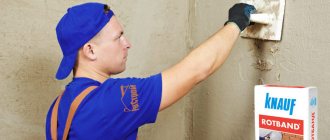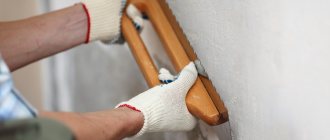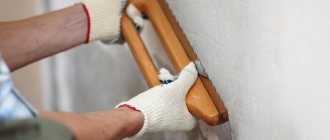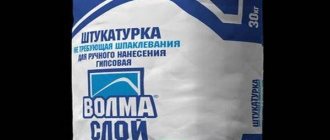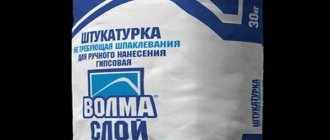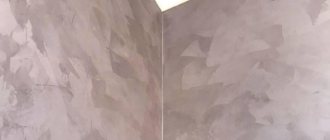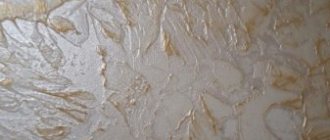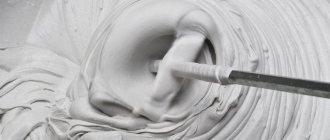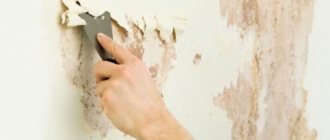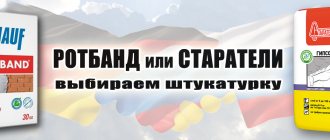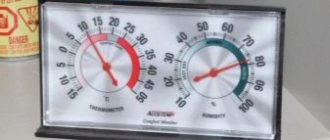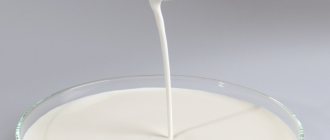Rotband plaster is a multifunctional gypsum mixture that contains polymer impurities that increase adhesion (adhesion). This technical characteristic allows the mixture to adhere to the base.
The main task is manual plastering with high quality, ceilings, walls from bases which are concrete, brick, polystyrene foam, cement. It is recommended to use in rooms where humidity is normalized. Gypsum absorbs moisture very well.
Works especially well on smooth concrete surfaces, vertical and horizontal. Knauf Rotband gypsum plaster has universal instructions on the bag. Therefore, there should be no problems. If it is torn or sealed, then read it on this page.
About plastering work and types of plaster mixtures
Surface plastering is a technological process in construction and repair aimed at leveling the surface, creating the correct geometry of the room and creating an intermediate protective layer between the finishing and the rough base. Also, a layer of plaster can serve as a technical layer for installing hidden wiring in houses where gating is prohibited.
By type, plaster mixtures are divided into:
- Cement;
- Calcareous;
- Plaster;
- Clay;
- Calcareous-clayey;
- Lime-gypsum;
- Lime-cement.
Rotband plaster belongs to the class of gypsum plasters for manual application.
Rotband 5 kg Bag 30 kg
Types of putty
In total, Knauf has three types of putty. Next we will consider the varieties of Rotband Knauf putty.
Where is Rotband used?
According to the technical documentation of the KNAUF company, namely, it is the manufacturer of Rotband in Russia, this plaster mixture can be used:
- Without a protective layer, only for interior work, in rooms with normal humidity;
- When protecting the plaster layer with tiles or other water-repellent material, in bathrooms and kitchens.
Simply put, if you decide to level and paint the wall, then you can use Rotband only in dry areas of the apartment. If you decide to level the wall and cover it with ceramic tiles or plastic, you can use Rotband everywhere.
Thanks to the polymers included in this mixture, it can be applied to the following surfaces of the walls and ceiling of the apartment:
- Concrete;
- Brick;
- Pre-plastered with cement mortar;
- DSP boards;
- Expanded polystyrene (!).
According to Rotband practice, plaster is applied to any durable surface coated with a primer such as concrete contact, including:
- On plasterboard for local leveling of differences in plasterboard surfaces;
- On ceramic tiles;
- On OSB, chipboard boards.
Rotband is NOT used for leveling floors. Can be used to seal cracks and holes in the floor for subsequent installation of screed or self-leveling floor.
History of the Knauf company
The Knauf company was born in 1932 in Germany. It was invented by the Knauf brothers. One brother was called Karl, and the other was Alflns. In 1949, a company was opened that was engaged in the production of gypsum putties.
Since 1993, this company began working in Russia.
The putty is manufactured according to international requirements. Each product has a certificate.
Two main advantages of Rotband
The first advantage is a thick layer at a time. Rotband plaster can be applied to the surface in a thick layer of up to 50 mm without the spraying stage. That is, if you need to level the wall by 4-5 cm, place beacons on the wall and plaster it with Rotband mixture in one pass.
The second advantage is that no puttying is required. With high-quality mixing and repeated tightening, you will usually get a smooth wall, which, after covering and simple grinding, does not need to be puttied.
Note: The gypsum mixture can be applied in several layers, waiting for the previous layer to dry completely. This allows you to level walls (ceilings) with unevenness of more than 50 mm.
Main characteristics of plaster
Knauf specialists keep the exact composition and production technology of the Rotband mixture a secret. Only the components that ensure the high quality of this building material are well known:
- gypsum powder with additives that improve water absorption and prevent shrinkage after application;
- plasticizers that increase ductility;
- dusty filler with a fine-crystalline structure, ensuring the resistance of the finished coating to external influences.
To work, you just need to dilute the mixture with water in the proportion recommended by the instructions and start applying it to the desired surface.
How to work with the mixture
Within the framework of a small apartment renovation, I work in Rotband 5 kg like this:
- I pour 3 liters of cold tap water into a clean 20-liter bucket;
- I pour two handfuls of the mixture into the water;
- I stir the mixture with a mixer at low speed;
- I fill up the rest of the mixture from a 5 kg bag;
- I always stir the mixture at low speed, so as not to stir up air bubbles, until a thick, homogeneous mass is formed;
- I let the solution sit for 3-4 minutes;
- Once again I mix the prepared solution with a mixer;
- I insert a narrow spatula (10 cm) into the mixture. The spatula should stand in the mixture without falling to the sides;
- The mixture is ready to work.
Applying the mixture
The mixture is applied to a pre-primed, dry surface, between the plaster beacons set at the same level.
I apply the mixture dry (no need for excess water), with a clean spatula 100-150 mm wide or with a trowel (no debris). The method of throwing the mixture is from bottom to top. When poured, the mixture crashes into the wall, increasing the density of the solution. If you can't apply it, just press the mixture into the wall.
You need to throw enough mixture onto the wall so that it protrudes beyond the beacons on all surfaces by 5-15 mm.
Next, I take the rule with a capture of 1.5 meters. Lighthouses must fall under the capture rule. Moving the rule along the beacons, from bottom to top with pressure, I remove the excess mixture with it. I dump the excess mixture back into the bucket.
I repeat casting and pulling the mixture several times until the surface is completely leveled.
If, when stretched, the mixture begins to “flow,” then the solution is too liquid. If the mixture begins to stick, lightly moisten the surface (not the wall) with water.
Thus, in stripes, from bottom to top, from corner to corner, the entire wall is plastered. Let me draw your attention: the first and last beacon are placed at a distance of 20-30 cm from the corner. These “remnant” strips are plastered after the main areas.
The consumption of the mixture, according to documents, with a layer of 1 cm is 8.5 kg/m2.
Take out the beacons
After the mixture has hardened, after 2-3 hours, the beacons must be removed. The next day, the furrows from the beacons need to be cleaned, if necessary, moistened and sealed (hammered) with the same mixture.
Grout (grinding) Rotband
The last stage of working with gypsum plaster is the grouting stage, similar to covering and grinding when working with a cement-sand mixture.
The layer of gypsum plaster can be rubbed with a metal spatula or a metal trowel after first wetting the surface with water. If there are many pits and technological defects on the surface, Rotband liquid solution is used for leveling and smoothing. To avoid shrinkage cracks, coating and grinding of any plaster should be carried out the next day.
Drying the putty
- A layer of one millimeter dries within 24 hours. And a layer of three millimeters - within three days.
- Humidity should not be more than 60 percent.
Color palette
It comes in pink, gray and white. Depends on the additives.
Using pink putty, the walls are perfectly smooth. And after gray and white putty, waves form on the surface. They will need to be smoothed out.
Consumer Reviews
An undoubted advantage is that during operation this plaster does not crumble at all.
- Among the disadvantages, they note that it is inconvenient to apply to walls. After adding water it turns out very liquid. It is advised to add less water than what is written in the instructions.
- After drying, some people notice that the color of the walls is not quite white.
- Consumers think it's worth the money.
This plaster can be found in almost any hardware store.
